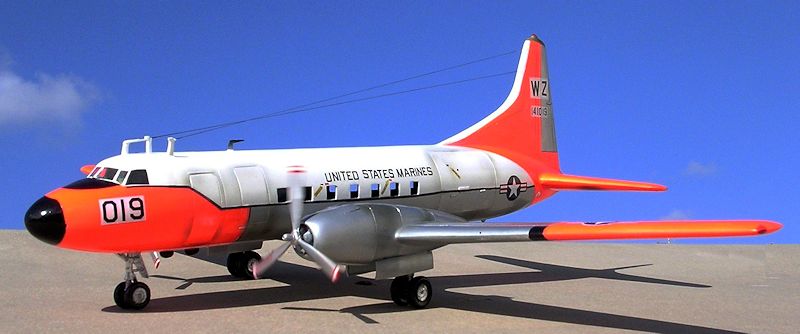
Execuform 1/72 C-131F
| KIT #: | ? |
| PRICE: | $30.00 |
| DECALS: | None provided |
| REVIEWER: | Carmel J. Attard |
| NOTES: | SVacuform with metal and resin parts |

| HISTORY |
In
the
late
1940's
a new generation of prop-driven airliners was emerging that reflected the
strides in technology made during WWII. These were namely the DC6 and
Constellation L-1049 of which the US Navy
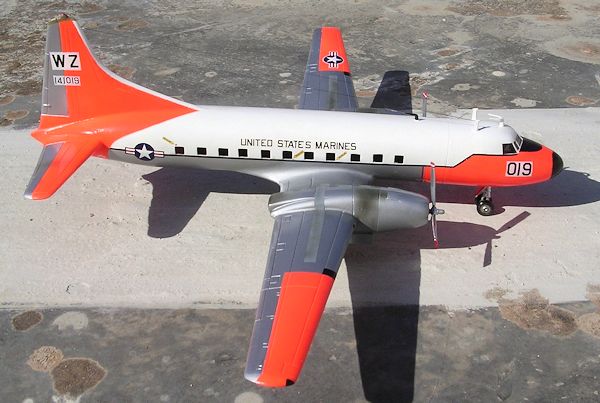 made good
use of them. The Navy ordered both these in 1950s, as the R6D-1 (C-118B) and
R7V-1 (C-121S). Even the venerable DC-3 was produced by the Navy in 1951 as
R4D-8 (C-117).
made good
use of them. The Navy ordered both these in 1950s, as the R6D-1 (C-118B) and
R7V-1 (C-121S). Even the venerable DC-3 was produced by the Navy in 1951 as
R4D-8 (C-117).
In early 1954 the
Navy found itself in need of a larger high-performance, twin-engine transport
aircraft for use as short and medium range cargo and passenger runs. With
successful operations of the civil Convair 240s and the USAF C-29s navigation
trainers and with little competition from other designers the updated version of
the Convair model 340 liners was picked.
In December 1953 the
Navy satisfied its immediate needs by ordering a single R4Y2 Samaritan under
contract No 54-602. The aircraft was converted from a civil version into a
military VIP with reduced seating for 24. The airplane entered service as Bu No
140378 late in April 1954 and was based at NAS Anacosta, Washington DC. The
aircraft was assigned to the Assistant Secretary of the Navy carrying Navy and
government leaders throughout the East Coast area.
Shortly after delivery the Navy
assigned a second contract with Convair for 36 convertible cargo/ passenger
R4Y-1 Samaritan (Bu No 140993-141028) redesigned as C-131F in mid 1962. The
R4Y-1s (Convair
340-71) had 13% increase in wing area over model 340 and carried 44 rear-facing
passengers. The Convair had a maximum speed of 275 mph, a range of 2100 nautical
miles and service ceiling of 25,500 ft. Noteworthy features with this aircraft
was that it was the first twin-engine Navy transport to use tricycle
undercarriage, each with twin tires for adding safety. The three blade Hamilton
Standard propellers were identical to those used on the4-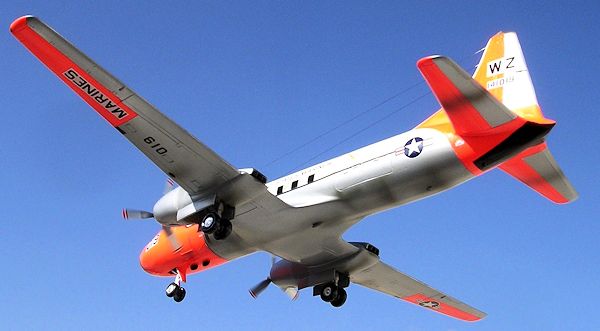 engine
R6D-1 Liftmaster. It also featured the standard Convair-liner folding stairways
in forward main entrance door. It had a strengthened cabin floor for cargo loads
and a large left cargo door that swings upwards to produce 6x 10 opening.
engine
R6D-1 Liftmaster. It also featured the standard Convair-liner folding stairways
in forward main entrance door. It had a strengthened cabin floor for cargo loads
and a large left cargo door that swings upwards to produce 6x 10 opening.
At one time during
the late 1950 all the R4Y-1s were put through a modernization programme that
much resembled to Convair 440 standard. This included replacing the twin tubes
exhaust outlets (T-29 type) to more streamlined rectangular ones improving
engine cooling and cabin noise levels. An elongated weather mapping radar nose
was also installed as well as standard modifications that increased the airplane
gross weight to 53,200 lbs.
In general the
C-131B which was in line with Convair 440 series was a stretched and improved
version of the model 240 with 16 added forward of the wing and 38 added aft.
This increase in cabin length enabled an additional row of passengers to be
fitted. The wing area increased 103 Sq Ft bringing 920 Sq Ft. Wing span
increased 137 to 105 4. Engine nacelle also increased 7 forward of wing.
The 400 also differed from the 340 in having more closely fitted engine cowls
and with rectangular exhaust outlets as indicated earlier. Other improvements
were addition of aileron and flap seals and improved soundproofing.
The C-131F represented in the kit
livery was in the shape it was on 23rd April 1964 (50 years to date) while
assigned to the Fleet Marine Force Pacific at MCSA El Toro. Since its delivery
on22nd March 1956 the aircraft was assigned to MCAS El Toro, Cal; Anacosta; back
to El Toro HQ, then to MCAS Kaneohe, Hawaii; El Toro; MASDA Davis-Montan,
Arizona and was stricken on 29th
June 1978 with 13,329 hours logged.
Both Civilian and
military versions of the Convair series aircraft were a common sight in Maltese
skies during the 1960s and the following are typical movements of the type
landing at Hal Luqa airfield.
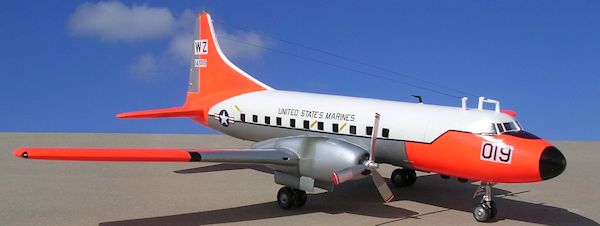 11.5.64
Convair 440 CA-033 Luftwaffe
11.5.64
Convair 440 CA-033 Luftwaffe
15.5.64
28.5.64
C-131
42822 USAF
18.6.64
VT-29B
15118 USAF
21.7.64
Convair 340 PH-CGD Martinair Holland
24.8.64
C-131F
141020 USN Naples model 340-71
27.10.64 C-131F
26892
USN Naples
17.11.64 C-131F
141011 USN Naples
20.12.64 Convair
440 SM-2 mm61899 Italian AF
15.3.65
C-131F 141020 USN Naples
23.3.65
VC-121 2607 81615 Wheelus AB
22.4.65
Convair
340 PH-CGD Martinair Holland
5.6.65
VT-29B
USAF HQ 3rd AF Northolt
4.10.65
C-131F 141020 USN Naples
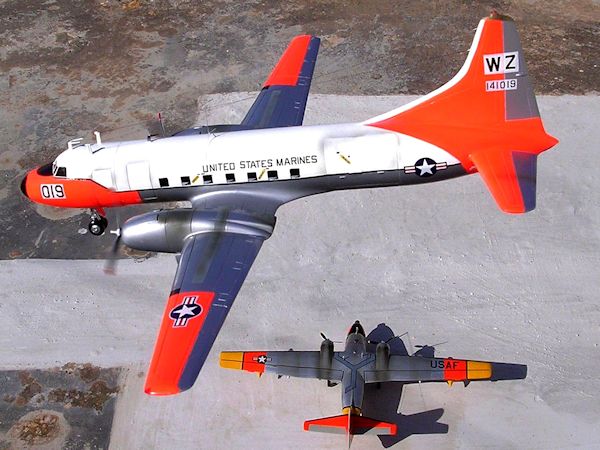 6.10.65
VT-29D 0-25832 USN Naples
6.10.65
VT-29D 0-25832 USN Naples
21.10.65 Convair
440 YU-AND J.A.T.
9.2.66
C-131F
142822 USN
14.3.66
C-131A 0-25798 cn 53-18
21.3.66
C-131A
25802 cn 53-22
3.5.66
C-131F
141018 US Atlantic Fleet
7.5.66
T-29B13812
USAF
8.5.66
VT-29B
17899 HQ 3rd AF
28.6.66
VC-131D
cn 232 Wiesbaden
19.6.66 VC-131D 42822 USAF Wiesbaden
| THE KIT |
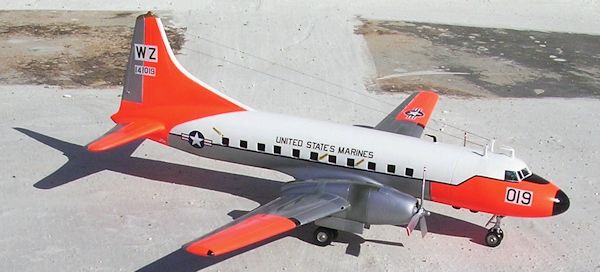
As at first
glance the impression is that the C-131F is a slightly bigger aircraft to its
predecessor T-29.
| CONSTRUCTION |
| COLORS & MARKINGS |
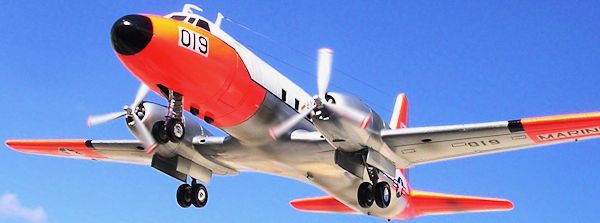
| CONCLUSIONS |
| REFERENCES |
April 2013
Thanks to If you would like your product reviewed fairly and fairly quickly, please contact the editor or see other details in the Note to Contributors.